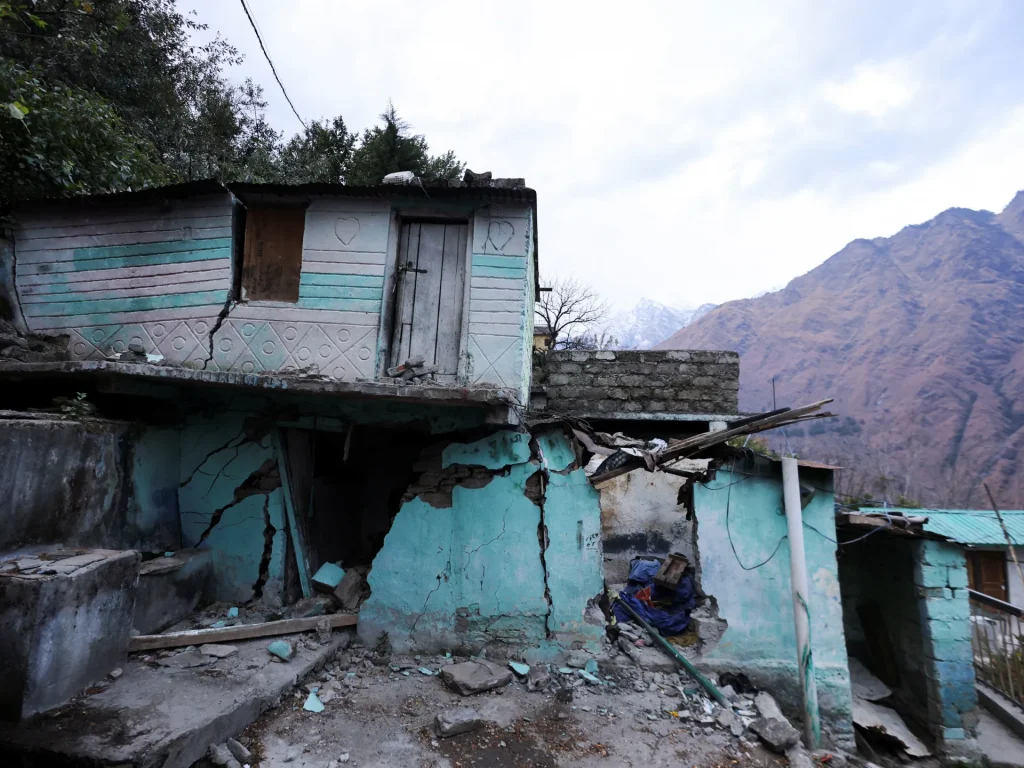India is facing a critical situation as many parts of the country are sinking, and the town of Joshimath in Uttarakhand’s Chamoli district is a glaring example. With a population of over 20,000 people, this Himalayan town is gradually sinking into the ground due to several factors. In this article, we will explore the story of India’s sinking town and discuss potential solutions to prevent such disasters in the future.

Chapter 1: The Unfolding Crisis
Joshimath, also known as Jyotirmath, holds immense religious, tourism, and military significance. It serves as a crucial stop for people visiting Badrinath and is a vital location due to its proximity to the disputed border between India and China. However, in recent years, this once-thriving town has been experiencing a series of cracks and subsidence.
Chapter 2: The Origins of the Problem
The sinking of Joshimath can be traced back to heavy rainfall and floods that occurred in 2021. These natural disasters led to numerous cracks in the town’s buildings, rendering them unsafe. Astonishingly, despite the declaration of these buildings as unsafe, construction activities continued until January 2023. Many experts believe that this further exacerbated the situation.
Over the course of just two years, from 2020 to 2022, the entire area sank by 2.5 inches, a phenomenon known as land subsidence. It is crucial to note that the Himalayas are relatively young mountains that continue to grow taller each year. The constant movement and pushing of tectonic plates contribute to earthquakes in the region and make the area highly unstable.
Chapter 3: The Truth Hidden in Plain Sight
The sinking of Joshimath is not an isolated incident but rather part of a more extensive problem in Uttarakhand. As many as 395 villages in the region fall under disaster-prone areas, making any development projects highly risky. In fact, as early as 1976, the Mishra committee warned of the unsuitability of the land for development due to its instability caused by earthquakes, flooding, and water percolation.
It is disheartening to see that despite prior knowledge of the risks involved, adequate action was not taken. Furthermore, recent research conducted by ISRO has been mysteriously removed. One must question the government’s intentions and what they may be trying to hide.
Chapter 4: Seeking Solutions
While it is easy to become disheartened by the current state of affairs, it is essential to remember that no problem is without a solution. Looking to our neighboring country, China, provides us with valuable insights. After a massive earthquake in 2014, researchers in Hong Kong explored materials that could resist earthquakes. They discovered that clay and bamboo are excellent building materials for earthquake-prone areas, as they offer lightweight yet robust structures.
Japan, a country prone to tsunamis, also serves as inspiration in dealing with natural disasters. Rather than halting development, they have learned to live in harmony with nature, implementing suitable construction methods and respecting the environment’s boundaries.
Chapter 5: Confronting the Challenge
To overcome the sinking crisis and ensure sustainable development, we must first acknowledge the problem at hand. India must adopt a disaster-resistant infrastructure plan, focusing on smaller-scale projects and sustainable practices. The 1976 Mishra committee report provides an excellent starting point, defining eight principles for sustainable development.
India’s fate is at stake, and urgent measures need to be taken. Climate change has already made India the fifth-most vulnerable country in the world, and the impact will only intensify. Cities like Mumbai, Kochi, Mangalore, Chennai, and Vishakhapatnam are at risk of sinking within the next 50 years due to rising water levels. It is crucial for the government to prioritize environmental education and conservation, rather than exploiting the land for short-term gain.
Conclusion
when there is a conflict between environment and development. Then a grey area is formed And it needs to be approached very sensitively.
Because even if slightly, The balance is disturbed.
Then it has a direct impact on the people there But before solving a problem. People need to accept That there is a problem. There has been a mistake. This is an ecologically sensitive zone.
The focus here must not be To bring big projects here for faster development Instead it must be
about smaller projects and sustainable development.Almost 50 years ago, Mishra committee had given us 8 pointers.Through ,which we can do sustainable development.India is drowning And this is not an exageration.
This is the truth Global Climate Risk Index says India is the 5th most vulnerable country in the world. Climate change is going to have a big impact on us. As the water levels will rise
Cities like Mumbai, Kochi,Mangalore, Chennai, Vishakhapatnam will start sinkingAnd this is not going to happen in the next 500 years.
It is going to happen in the next 50 years.
You see, in our schools EVS ,was an optional subject.The question is does the Govt. too take this subject as an optional In the name of development why do they abuse our land?
Pakistan’s whole economy today is about to collapse due to a flood.If we want to save India. Then we have to take this as a warning sign and immediately, Take the correct steps If you got some value



